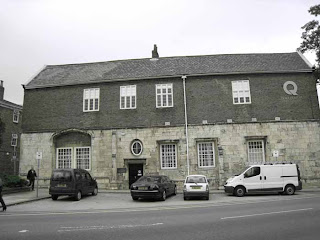Three things today.
First, the answer to the question everyone is asking: YES!! I’m in Quilt National 2009!
And now I have to fill out a very welcome number of forms...the most enjoyable form filling I've done in ages!
What’s most exciting is that the jurors chose one of the black and white pieces about which I was a little uncertain since they are much bolder and more graphic than work I’ve done in the past. I’ve made about 12 of them now – you can see several on the Buildings page on my web site.
http://ebarton.myweb.uga.edu/abstractquilts.htm
It’s always difficult when the Muse leads you off onto new ground. I find it very hard to judge my own work either objectively or subjectively!!! Usually I have to put a piece away for months so that I can see it with “fresh eyes”. It's great to know it's good enough for QN!
Pauline Burbidge and my excellent travelling companion Julia in Pauline's studio. you can see more of Pauline's work on her website.
This is Eilean Donan castle - taken from the window of our room at the Bed & Breakfast we stayed at!!! of course it was pouring with rain - atmosphere laid on specially for us!! absolutely magic!
Ullapool
A lovely little town, fabulous views across the loch - and a great bookstore!
 I'm attempting to run away with an Andy Goldsworthy sculpture!! This lovely pine cone is in the Edinburgh Botanical Garden.
I'm attempting to run away with an Andy Goldsworthy sculpture!! This lovely pine cone is in the Edinburgh Botanical Garden.
Finally, this is the new UK National Patchwork Museum in my home town of York - well worth a visit. they have both traditional and contemporary work - no pictures allowed alas. My favorites were the Burbidge and the Kemshall......and a 300 year old anonymous quilt - so softened by time that it was like a delicate frail leaf...
Personal vision
A propos of what I was writing about yesterday : “What struck me overall about all these artists was how clearly their work relates to their own personal and specific experiences”…
I came across this statement from Edward Hopper: “Great art is the outward expression of an inner life in the artist and this inner life will result in his personal vision of the world”.
Discovering your own voice is a result of really getting to know how you see and how you feel about what you see. It is a result of very thoughtfully watching yourself watch and react – and it takes time and practice. Like everything else – daily practice is best. Making your art (as do the artists I wrote about yesterday) based on your own personal experience will lead to honest, valid and individual work. Your own expression – as identifiable as your handwriting.
(Actually, I have lousy handwriting…a sort of demented italic….the nuns despaired of me… but … it’s identifiable!! On a good day, anyway..)
And if you have been, thanks for reading!











































